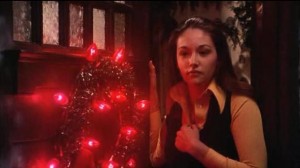HALLOWEEN WEEK 2021! BLACK CHRISTMAS (1974) “the first modern slasher movie.”
 “If this movie doesn’t make your skin crawl . . . it’s on too tight!” — advertising tagline for Black Christmas
“If this movie doesn’t make your skin crawl . . . it’s on too tight!” — advertising tagline for Black Christmas
Canada is a nation of firsts. Torontonian Don Munroe built the first table hockey game here in the early 1930s. Other parts of the country can lay claim to the Jolly Jumper, the celebration of Labour Day, artificial hearts, the Robertson square-head screwdriver, and it was a Canadian who mixed the world’s first Bloody Caesar. The country has broken ground in many fields, including film. Florence Lawrence, the first performer to be identified by name on screen, was born in Hamilton, Ontario, while the first aboriginal actor to portray a Native American on television, Jay Silverheels, hailed from the Six Nations Indian Reserve in Brantford, Ontario.
In a more macabre vein, without a groundbreaking 1974 Canadian horror film there might never have been a Jason Voorhees, Freddy Krueger or Michael Myers. Between them the gruesome threesome have sliced and diced their way through at least two dozen movies, but the mayhem they imposed on promiscuous college girls and studly teens owes much to one film made in Toronto, a movie Film Threat magazine calls “the first modern slasher movie.”
Director Bob Clark didn’t invent the slasher film with Black Christmas — arguably Psycho, Peeping Tom or Bay of Blood (Reazione a catena) were the granddaddies of gore — but he did establish the format. Mix and match the fear of an unwelcome visitor to a sorority house brimming with randy college girls, a holiday-turned-violent theme, the anonymous phone call used to terrorize girls, a motiveless killer, a mysterious male stalking young women, and a female lead who must conquer her own fear in order to stay alive and you have the plot of dozens of films that were to follow.
Shot in Toronto between February and May 1974 on a budget of roughly $600,000, Black Christmas is about an unseen psychotic killer named Billy who makes disturbing, obscenity laced phone calls to a group of sorority girls. Soon he escalates from one-sided phone sex to dispatching the girls one by one in brutal fashion.
“It was originally called Stop Me,” says Clark, who was killed in an April 2007 car accident, “I don’t think I’m taking unfair credit, but Black Christmas was my title, my idea. I love the contrast of the idea of Christmas, the jolliest of all seasons with this dark kind of imagery. Both a horror film and Christmas have tremendous trappings that make a nice juxtaposition.”
Apparently others agreed with him. In the next two decades a tsunami of holiday themed horrors — Christmas and otherwise — drifted into theaters; My Bloody Valentine, New Year’s Evil, April Fools Day and a Santa’s sack of movies featuring death by Christmas tree light.
What sets Black Christmas apart from the rest of the Christmas horror pack are the memorable characters. The standout is a pre-Lois Lane Margot Kidder as the sharp-featured brunette Barb, whose alcoholic tendencies foreshadowed the actress’s troubled real life. “One of my favorite memories is Margot coming to the set for her famous turtles-screwing-for-three-days scene,” says Clark. “She was supposed to be imbibing, and she was, to get in character. She was definitely there.”
As Barb she thumbs her nose at any form of authority — be it the thick as a brick Sgt. Nash or the threatening caller — and steals every scene she’s in with her reckless energy. When she slurs, “This is a sorority house, not a convent,” it is lewd, raunchy and sexy-funny.
Argentine-born Olivia Hussey as Jess is not the typical sorority slasher movie heroine. Hussey brings a quiet strength to Jess that hints at a fountain of inner resolve. It has often been said that slasher films are the most Republican of genres because of the punishment meted out on people who go against conservative middle-American values. In other words smoking pot and jumping from bed to bed is bound to earn you a one way ticket to hell courtesy of some masked madman, while the virgin of the group usually makes it through bloodied but unbowed. In Black Christmas Jess rebels against her boyfriend, and is planning to have an abortion. Clearly she is no virgin, and yet she is the sole survivor of Billy’s rampage.
The boyfriends of Claire and Jess — Chris Hayden (Art Hindle) and Peter Smythe (Keir Dullea) — are studies in opposites. The Halifax-born Hindle plays Chris as earnest and loving (although he does wear a raccoon coat), a stand-up guy who loves his girlfriend even if their relationship is chaste.
Keir Dullea as Peter is a different story. Peter is an eccentric musician who realizes too late that he has traded one passion for another. His love of music overshadowed his feelings for Jess and now she is backing away from him. He is prone to fits of anger, and this hot-headed behavior is the perfect red herring (or McGuffin as Hitchcock used to call them) to make us think he is the killer. It is interesting to imagine how the character might have differed if Clark’s first choice for Peter, Malcolm McDowell, had accepted the part.
During shooting Dullea was only available for a week as he had other commitments in Europe. In his short time on the film, he never met Margot Kidder and worked with John Saxon only briefly. “My total experience with working with anybody was Olivia Hussey,” he says. Clark shot all of Dullea’s scenes first and in editing made it appear as though he was there for the whole time.
Like Black Christmas’s other imported movie star, Olivia Hussey, Keir Dullea’s early career showed great promise, but didn’t mature into full-blown movie stardom. Two films hinted at his star potential — 1963’s Lisa and David and Bunny Lake is Missing in 1965 — but it wasn’t until he played astronaut Dave Bowman in Kubrick’s 2001: A Space Odyssey in 1968 that his full promise was reached. He failed to really capitalize on the notoriety that movie earned him, leading Noel Coward to famously quip, “Keir Dullea, gone tomorrow.”
Uncredited but very effective are the actors who voiced the obscene phone calls. The disembodied voices of unseen evil were supplied by a number of people including Bob Clark, actor Nick Mancuso and several female actors. “[The phone calls are] a compilation of about five actor’s voices,” says Clark. “I remember what Nick brought it to was an intensity that certainly I had never seen before,” said sound designer and composer Carl Zitrer who engineered the calls, mixing in reverb and an array of spooky sounds.
Was Black Christmas the inspiration for John Carpenter’s seminal slasher flick Halloween? It’s a question that has sparked a fair amount of debate, so let’s break it down. There are similarities that cannot be denied between the two films.
Most obviously both films open with a point of view shot of the killer creeping around the outside of a house at night. Clark uses this shot, and many POV angles to great effect in Black Christmas, but he wasn’t the first to use the subjective camera to create fear. Clark simply took an old idea and put a new spin on it. He would later say that he hoped to break new ground by “employing some, if not new, certainly reworked and rethought cinematic ideas.” Mario Bava used distorted POV in Blood and Black Lace, and Hitchcock used it in the shower scene in Psycho, just to name a couple famous examples. Clark’s innovation in Black Christmas was to make the point of view shot his centerpiece, using it create a mood of terror rather than a secondary complement to the horror already on screen.
Clark’s film is unique in that we never see the killer, he moves in the shadows, a subliminal figure of terror unlike the very visible Michael Myers in Halloween. What they share, however, is motive – neither of them has one. They are striking out at these victims for no reason. Carpenter says he modelled Michael Myers’ relentless passion for killing on a film by Michael Crichton. “I must tell you that I cribbed from Westworld – Yul Brynner as a robot gunfighter who malfunctions and keeps coming after them. I just took it a step further, but I gave you no explanation.” Pre-Black Christmas movie homicidal maniacs always had a motive, but we never know why Billy targeted the Pi Kappa Sig house or its inhabitants.
There is one major difference between the two – Billy is literally a raving lunatic, screaming and grunting his way through the film, whereas Michael Myers (and later, Jason Voorhees) is unnaturally silent.
It may have just been weird synchronicity that two films about homicidal maniacs open with unusual POV shots, and share an ideological bent, but there is no question that Black Christmas and Halloween are similar.
“I absolve John Carpenter every time,” says Clark. “The facts are that I was going to direct a film John wrote a couple of years after Black Christmas. He was a big fan of Black Christmas… and he asked me if I was ever going to do a sequel.
“I said, ‘I would make it the following fall and somehow in the interim the killer had been caught and had been institutionalized. I would have him escape one night, and now he is free in the community… and he starts staking them again at the Black Christmas sorority house, and I was going to call it Halloween.’
“I think he was influenced by it, as were a few others. When you think about what John Carpenter did, [however], wrote a script — really quite different from that idea —directed it, edited it and did the music. It was a terrific piece of work. Maybe the title Halloween he should have given me a little of, but I didn’t own that either.”
Despite the rave reviews, and the prediction of Olivia Hussey’s personal psychic that the film would make a bundle, Black Christmas didn’t fare well at the box-office in the USA. To boost admissions, in some markets the movie’s name was changed to A Stranger in the House to avoid confusion with the flurry of blaxploitation films that were appearing at the time. It was also released as Silent Night, Evil Night.
Viewed through today’s eyes the movie holds up. It is very stylish, although slower in sections, and with a lower body count than modern horror fans are used to, but it is still capable, more than three decades after its conception, to raise goose bumps. A testament to the film’s enduring ability to scare came when NBC cancelled an airing of the film because they felt it was too intense for television audiences. It has also earned the seal of approval from Quentin Tarantino, who cites it as one of his favorite movies.
“It’s an interesting film.” says Clark, “I thought it was a good, scary, classic horror story, and those have a way of surviving.”


